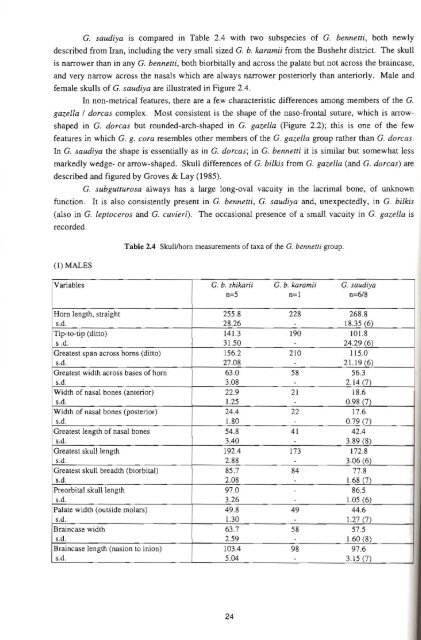CONSERVATION OF ARABIAN GAZELLES - Nwrc.gov.sa
CONSERVATION OF ARABIAN GAZELLES - Nwrc.gov.sa
CONSERVATION OF ARABIAN GAZELLES - Nwrc.gov.sa
You also want an ePaper? Increase the reach of your titles
YUMPU automatically turns print PDFs into web optimized ePapers that Google loves.
G. <strong>sa</strong>udiya is compared in Table 2.4 with two subspecies of G. bennetti, both newly<br />
described from Iran, including the very small sized G. b. karamii from the Bushehr district. The skull<br />
is narrower than in any G. bennetti, both biorbitally and across the palate but not across the braincase,<br />
and very narrow across the na<strong>sa</strong>ls which are always narrower posteriorly than anteriorly. Male and<br />
female skulls of G. <strong>sa</strong>udiya are illustrated in Figure 2.4.<br />
In non-metrical features, there are a few characteristic differences among members of the G.<br />
gazella 1 dorcas complex. Most consistent is the shape of the naso-frontal suture, which is arrowshaped<br />
in G. dorcas but rounded-arch-shaped in G. gazella (Figure 2.2); this is one of the few<br />
features in which G. g. cora resembles other members of the G. gazella group rather than G. dorcas.<br />
In G. <strong>sa</strong>udiya the shape is essentially as in G. dorcas; in G. bennetti it is similar but somewhat less<br />
markedly wedge- or arrow-shaped. Skull differences of G. bilkis from G. gazella (and G. dorcas) are<br />
described and figured by Groves & Lay (1985).<br />
G. subgurturo<strong>sa</strong> always has a large long-oval vacuity in the lacrimal bone, of unknown<br />
function. It is also consistently present in G. bennetti, G. <strong>sa</strong>udiya and, unexpectedly, in G. bilkis<br />
(also in G. leproceros and G. cuvieri). The occasional presence of a small vacuity in G. gazella is<br />
recorded.<br />
Table 2.4 Skullihorn measurements of taxa of the G. bennelli group.<br />
(I) MALES<br />
Variables<br />
G. b. shilwrii<br />
n=5<br />
G. b. Iwramii<br />
n=1<br />
G. <strong>sa</strong>udiya<br />
n=6/8<br />
Hom length, straight<br />
s.d .<br />
Tip-to-tip (ditto)<br />
s.d.<br />
Greatest span across horns (ditto)<br />
s.d.<br />
Greatest width across bases of hom<br />
s.d.<br />
Width of na<strong>sa</strong>l bones (anterior)<br />
s.d.<br />
Width of na<strong>sa</strong>l bones (posterior)<br />
s.d.<br />
Greatest length of na<strong>sa</strong>l bones<br />
s.d.<br />
Greatest skull length<br />
s.d.<br />
Greatest skull breadth (biorbital)<br />
s.d.<br />
Preorbital skull length<br />
s.d.<br />
Palate width (outside molars)<br />
s.d.<br />
Braincase width<br />
s.d.<br />
Braincase length (nasion to inion)<br />
s.d.<br />
255.8<br />
28.26<br />
141.3<br />
31.50<br />
156.2<br />
27.08<br />
63.0<br />
3.08<br />
22 .9<br />
1.25<br />
24.4<br />
1.80<br />
54.8<br />
3.40<br />
192.4<br />
2.88<br />
85.7<br />
2.08<br />
97.0<br />
3.26<br />
49.8<br />
1.30<br />
63.7<br />
2.59<br />
103.4<br />
5.04<br />
228<br />
-<br />
190<br />
-<br />
210<br />
-<br />
58<br />
-<br />
21<br />
-<br />
22<br />
-<br />
41<br />
-<br />
173<br />
-<br />
84<br />
-<br />
-<br />
-<br />
49<br />
-<br />
58<br />
-<br />
98<br />
-<br />
268.8<br />
18.35 (6)<br />
101.8<br />
24.29 (6)<br />
115.0<br />
21.I9(6)<br />
56.3<br />
2.14 (7)<br />
18.6<br />
0.98 (7)<br />
17.6<br />
0.79 (7)<br />
42.4<br />
3.89 (8)<br />
172.8<br />
3.06 (6)<br />
77.8<br />
1.68 (7)<br />
86.5 I<br />
1<br />
1.05 (6)<br />
44.6<br />
1.27 (7)<br />
57.5<br />
1.60 (8)<br />
97.6<br />
3. 15 (7)<br />
I<br />
24
















